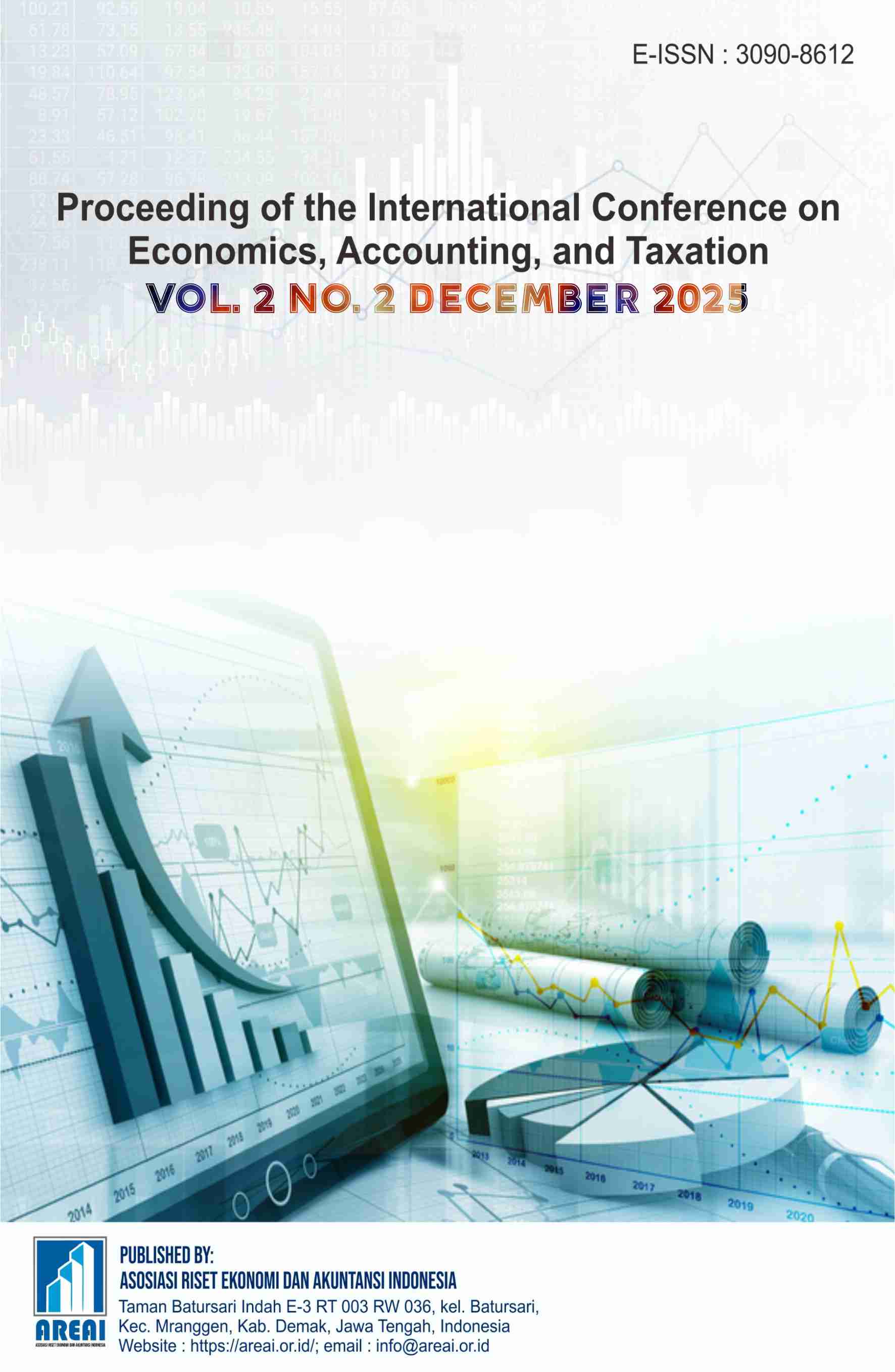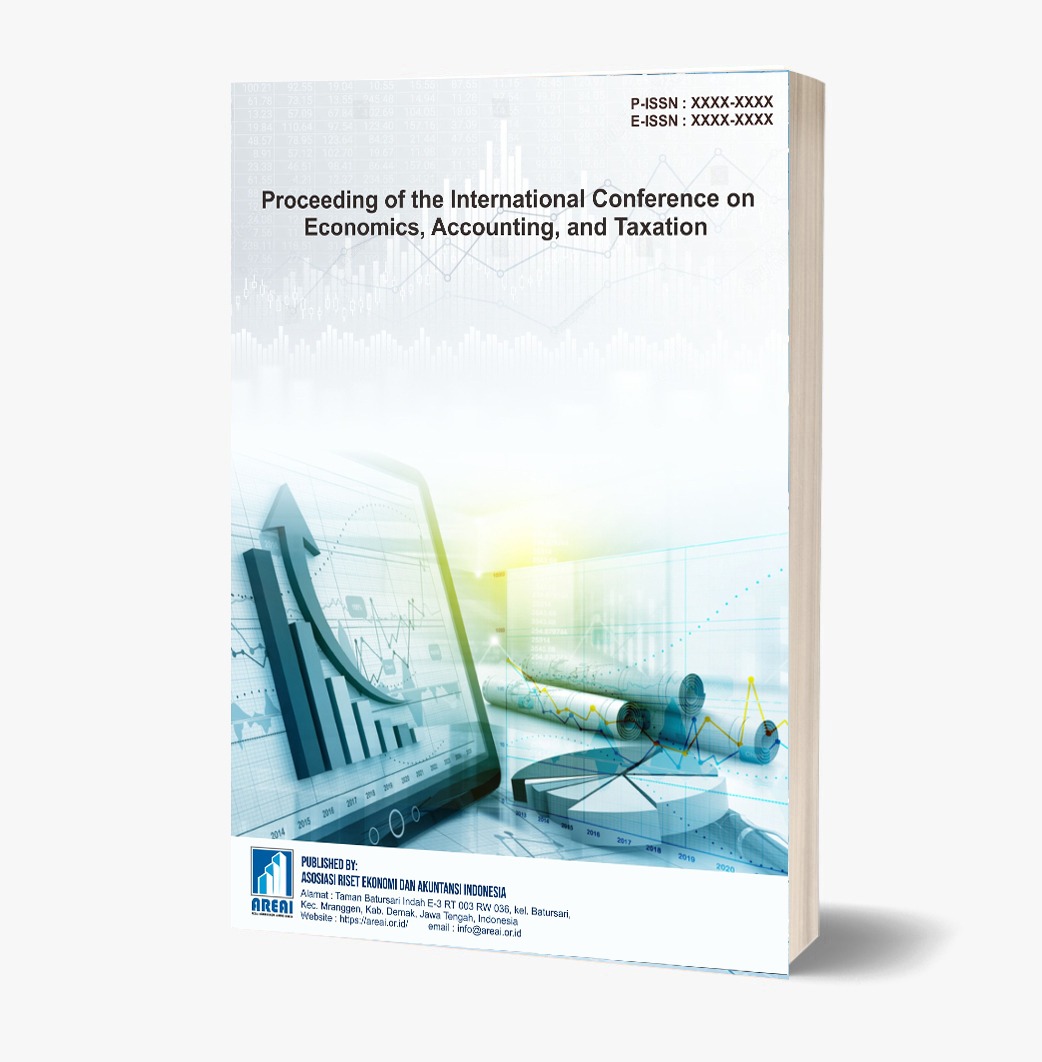Tax Avoidance Analysis through Capital Intensity, Inventory Intensity, and Leverage
DOI:
https://doi.org/10.61132/iceat.v2i2.148Keywords:
Capital Intensity, Effective Tax Rate (ETR), Inventory Intensity, Leverage, Tax AvoidanceAbstract
This study aims to present evidence on the effect of capital intensity, inventory intensity, and leverage disclosure on tax avoidance. This research utilizes secondary data from financial statements sourced from www.idx.co.id and the official websites of companies in the property and real estate sectors using quantitative research. The proxy used in measuring tax avoidance is using the effective tax rate (ETR) as the dependent variable and the independent variables used include capital intensity, inventory intensity, and leverage. Multiple linear regression analysis is the analysis technique used. The property and real estate sector listed on the IDX in the period 2021 to 2024 is the population in this study and the number of samples collected is 85 data obtained using the purposive sampling method. The findings of this research indicate that capital intensity, inventory intensity, and leverage significantly influence tax avoidance positively. These findings suggest that the higher the level of investment in fixed assets, inventory, and debt-to-equity ratio, the greater the tendency of a company to engage in tax avoidance.
Downloads
References
Adira, R. N., & Tanjung, J. (2025). Pengaruh likuiditas, leverage, komite audit, dan capital intensity terhadap agresivitas pajak: Studi pada perusahaan makanan dan minuman terdaftar di BEI. Equilibrium: Jurnal Ekonomi, 14(1), 185–200. https://doi.org/10.35906/equili.v14i1.2318
Adnan, M. R., & Haq, A. (2025). Pengaruh related party transaction, capital intensity, inventory intensity, dan sales growth terhadap tax avoidance. Jurnal Vokasi Akuntansi, 5(1), 429–440. https://doi.org/10.25105/v5i1.22321
Alif Videya, A., & Irawati, W. (2022). Pengaruh pertumbuhan penjualan, corporate social responsibility, intensitas aset tetap, dan intensitas persediaan terhadap tax avoidance. Jurnal Akuntansi Barelang, 7(1), 1–15. https://doi.org/10.33884/jab.v7i1.6340
Antaranews.com. (2025). BKPM: Sektor properti sumbang Rp122,9 triliun realisasi investasi 2024. https://www.antaranews.com/berita/4777085/bkpm-sektor-properti-sumbang-rp1229-triliun-realisasi-investasi-2024
Bakti, B. E. M., & Triyono. (2022). Analisis pengaruh mekanisme good corporate governance dan variabel keuangan terhadap nilai perusahaan (studi pada perusahaan sub sektor properti dan real estate yang terdaftar di Bursa Efek Indonesia). Jurnal Ekonomi dan Bisnis, 9(1), 104–111. https://doi.org/10.35137/jabk.v9i3.755
Bps.go.id. (2024). Realisasi pendapatan negara. https://www.bps.go.id/id/statistics-table/2/MTA3MCMy/realisasi-pendapatan-negara.html
Caroline, A., & Fajriana, I. (2023). Pengaruh leverage, capital intensity, dan sales growth terhadap tax avoidance (studi pada perusahaan sektor industri yang terdaftar di BEI tahun 2021–2023). Jurnal Ekonomi dan Bisnis, 5(2), 1–10.
Djatnicka, E. W., Purba, J., Ritonga, D., & Andriyani, M. (2022). Penghindaran pajak pada perusahaan properti dan real estate yang terdaftar di Bursa Efek Indonesia (BEI) periode 2016–2019. Jurnal Akuntansi Bisnis Pelita Bangsa, 7(1), 75–95. https://doi.org/10.37366/akubis.v7i01.432
Falefi, Y. A., & Istanti, S. L. W. (2024). Faktor-faktor yang berdampak pada tax avoidance perusahaan manufaktur yang tergabung di Bursa Efek Indonesia. Journal Economic Insights, 3(1), 1–10. https://doi.org/10.51792/jei.v3i2.106
Fazilah, L., Ahmad, A. W., & Rissi, D. M. (2024). Pengaruh kepemilikan institusional, capital intensity, inventory intensity, dan profitabilitas terhadap tax avoidance. Journal of Islamic Socio Economics, 2(4), 151–162. https://doi.org/10.59024/jise.v2i4.955
Firliana, B. P., & Yanto. (2024). Pengaruh capital intensity, profitabilitas, dan inventory intensity terhadap penghindaran pajak. Jurnal Riset Akuntansi, 8(2), 1–10. https://doi.org/10.34001/jra.v8i2.926
Ghani, A. S., & Sari, P. Z. (2023). The effect of capital intensity, inventory intensity, company size and leverage on tax avoidance in the coal mining sector on the Indonesia Stock Exchange 2017–2021. Journal of World Conference, 5(2), 77–83. http://proceedings.worldconference.id
Ghina, N., Herawati, R., Hapsari, D. I., & Purwantoro, P. (2024). Pengaruh transfer pricing, kepemilikan asing, dan intensitas modal terhadap penghindaran pajak. Ekonomika45: Jurnal Ilmiah Manajemen, Ekonomi Bisnis, Kewirausahaan, 11(2), 12–30. https://doi.org/10.30640/ekonomika45.v11i2.2293
Isnaini, R. S., Mukti, A. H., & Sianipar, P. B. H. (2024). Pengaruh transfer pricing, profitabilitas, dan leverage terhadap penghindaran pajak (studi empiris pada perusahaan yang terdaftar di BEI sektor aneka industri tahun 2019–2022). Sentri: Jurnal Riset Ilmiah, 3(2), 808–822. https://doi.org/10.55681/sentri.v3i2.2327
Jensen, M. C., & Meckling, W. H. (1976). Theory of the firm: Managerial behavior, agency costs and ownership structure. Journal of Financial Economics, 3(4), 305–360. https://doi.org/10.1057/9781137341280.0038
Kaloko, H., Kustiawan, M., & Fitriana. (2025). Analisis leverage, firm size, intensitas aset dan intensitas persediaan terhadap tax avoidance pada perusahaan sektor kimia yang terdaftar di Bursa Efek Indonesia tahun 2019–2022. Jurnal Akuntansi dan Keuangan, 7(1), 233–239.
Khaerany, R., Halihah, & Nirwana. (2024). Tax avoidance analysis in healthcare sector companies. Jurnal Ekonomi dan Bisnis, 2(1), 92–100.
Khayati, P. A., Minarso, B., Mardjono, E. S., & Setiawanta, Y. (2024). Indikasi agresivitas pajak pada perusahaan sektor energi di Bursa Efek Indonesia (BEI) tahun 2019–2023. Jurnal Akuntansi dan Ekonomi, 9(2), 116–125. https://doi.org/10.29407/jae.v9i2.23273
Komalasari, L., & Suharna. (2024). Pengaruh sales growth, capital intensity, dan inventory intensity terhadap tax avoidance. Jurnal Ilmiah Gema Ekonomi, 1(1), 1803–1811.
Kontan.co.id. (2025). Realisasi investasi sektor properti di Indonesia masuk lima besar. https://industri.kontan.co.id/news/realisasi-investasi-sektor-properti-di-indonesia-masuk-lima-besar
Maulana, T., Putri, A. A., & Marlina, E. (2022). Pengaruh capital intensity, intensitas persediaan, dan leverage terhadap agresivitas pajak (studi pada perusahaan pertambangan terdaftar IDX 2017–2021). Scientific Journal of Reflection: Economic, Accounting, Management and Business, 5(3), 829–842. https://doi.org/10.37481/sjr.v5i3.541
Nabilah, S., & Soedaryono, B. (2024). Pengaruh capital intensity, leverage, dan return on asset (ROA) terhadap penghindaran pajak (pada perusahaan sektor energi yang terdaftar di BEI periode 2019–2023). Jurnal Akuntansi dan Keuangan, 1192(3), 304–317.
Nasional.kontan.co.id. (2024). Menakar tantangan penerimaan pajak sektor informal di era digital. https://nasional.kontan.co.id/news/menakar-tantangan-penerimaan-pajak-sektor-informal-di-era-digital
Nauli Sipayung, E. S., Aulia Putri, Y., Henny, D., & Budi Yanti, H. (2023). Tax avoidance practices on the Indonesian stock exchange. Media Riset Akuntansi, Auditing & Informasi, 23(1), 169–182. https://doi.org/10.25105/mraai.v23i1.17274
Nisa, H., & Fitriyah. (2023). Pengaruh karakteristik perusahaan, capital intensity, dan inventory intensity terhadap agresivitas pajak. Jurnal Multiparadigma Akuntansi, 2(2), 2713–2726. https://doi.org/10.24034/jiaku.v2i2.5951
Ortax.org. (2023). Catat, aturan baru penyampaian laporan bagi WP PT Tbk. https://ortax.org/aturan-baru-penyampaian-laporan-wp-pt-tbk-pmk-40-2023
Pajak.go.id. (2024). Manfaat pajak untuk program pembangunan dan kesejahteraan masyarakat. https://www.pajak.go.id/id/artikel/manfaat-pajak-untuk-program-pembangunan-dan-kesejahteraan-masyarakat
Pakpahan, F. C., Malau, H., & Susanti, M. (2024). The effect of profitability, leverage, and green accounting on tax avoidance in the PEFINDO 25 index for the period 2018–2022. Jurnal Akuntansi dan Keuangan, 7(1), 1–10.
Rahardja, G. D., & Ngadiman. (2024). Pengaruh transfer pricing, sales growth, dan leverage terhadap tax avoidance. Jurnal Pajak dan Akuntansi, 6(1), 269–278. https://doi.org/10.24912/jpa.v6i1.29922
Ramadhani, N., Afifi, Z., & Ashsifa, I. (2024). Pengaruh kepemilikan institusional, capital intensity, inventory intensity, dan transfer pricing terhadap tax avoidance pada perusahaan energi yang terdaftar di BEI periode 2018–2022. Accounting Journal Indonesia, 2(2), 2018–2022. https://doi.org/10.35316/aji.v2i2.5669
Rasya, A. P. A., & Ratnawati, J. (2023). Faktor-faktor memengaruhi praktik penghindaran pajak (sektor pertambangan tahun 2019–2021). Jurnal Ecodemica: Jurnal Ekonomi Manajemen dan Bisnis, 7(2), 178–189. https://doi.org/10.31294/eco.v7i2.15474
Rosadani, N. S. P., & Wulandari, S. (2023). Pengaruh profitabilitas, capital intensity, ukuran perusahaan, dan sales growth terhadap agresivitas pajak. Jurnal Riset Terapan Akuntansi, 7(1), 27–39. https://jurnal.polsri.ac.id/index.php/jrtap/article/view/6334
Setiawan, D. (2024). Pengaruh manajemen laba, likuiditas, leverage, dan profitabilitas terhadap tax avoidance perusahaan dasar dan kimia yang terdaftar di BEI periode 2019–2023. Jurnal Profit, 2(3), 1–10. https://doi.org/10.58192/profit.v2i3.985
Setiawati, L., & Tanggreini, F. L. (2025). The influence of capital intensity, inventory intensity, and sales growth on tax aggressiveness in manufacturing companies. Jurnal Ekonomi dan Akuntansi, 3(1), 158–167.
Syach, R. A., & Witono, B. (2024). Pengaruh manajemen laba, profitabilitas, leverage, dan capital intensity terhadap agresivitas pajak. Jurnal Akuntansi dan Keuangan, 18(2), 1452–1473. https://digilib.uns.ac.id/dokumen/detail/112193
Taxjustice.net. (2025). Vulnerabilities to illicit financial flows: Complementing national risk assessments. https://taxjustice.net/2025/04/10/vulnerabilities-to-illicit-financial-flows-complementing-national-risk-assessments/
Wizanasari. (2024). Pengaruh capital intensity dan kepemilikan institusional terhadap tax avoidance (studi empiris pada perusahaan sub sektor makanan dan minuman yang terdaftar di Bursa Efek Indonesia tahun 2017–2021). Jurnal Penkomi: Kajian Pendidikan dan Ekonomi, 7(1), 366–379.
Zulfa, R. N., Setiyaningrum, S., Khasanah, N. K., & Gunawan, A. (2025). Pengaruh ROA dan leverage terhadap tax avoidance pada perusahaan kosmetik di BEI tahun 2021–2023. Jurnal Ekonomi dan Bisnis, 3(1), 195–222. https://doi.org/10.1201/9781032622408-13
Downloads
Published
How to Cite
Issue
Section
License
Copyright (c) 2025 Proceeding of the International Conference on Economics, Accounting, and Taxation

This work is licensed under a Creative Commons Attribution-ShareAlike 4.0 International License.






